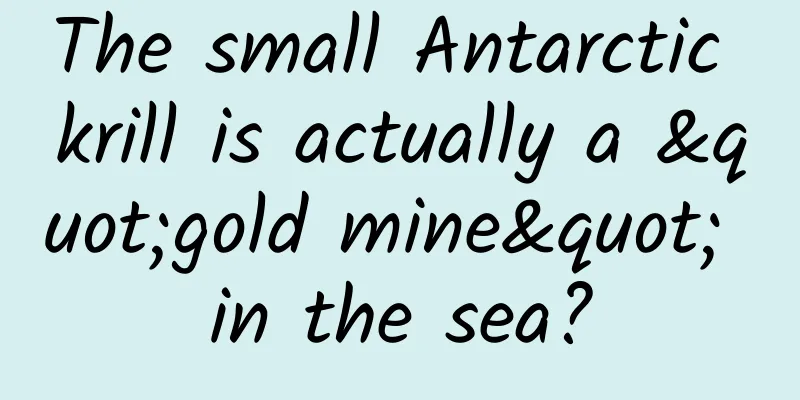The small Antarctic krill is actually a "gold mine" in the sea?

|
Under the Antarctic glaciers, there are rich and colorful creatures, and Antarctic krill is one of them. Antarctic krill are very small, with a body length of 3-5 cm and a weight of generally no more than 2 grams. They are translucent and light red throughout. They are at the bottom of the marine food chain and mainly feed on phytoplankton, especially tiny diatoms. Krill can emit light, and the light-emitting organs are located in the middle of the head and body. Relying on the effect of phosphorus, they can emit yellow-green light every 2-3 seconds, just like a miniature flashlight. Thousands of Antarctic krill gathered together are simply a "gold mine on the sea". They have strong vitality. Not only can they adapt to the harsh polar day and night environment of Antarctica, but they are also extremely resistant to hunger. They can grow by molting during the harsh and long winter in Antarctica. Antarctic krill is a key species in the Antarctic ecosystem and the animal with the largest biomass on Earth. It is often used as the main food by whales, seals, fur seals, penguins and other animals. A giant blue whale with a length of 25 meters can catch 4 tons of krill a day. The reason why these animals have such a big appetite and krill still exist in large quantities is attributed to the crazy reproduction rate of Antarctic krill. Every summer, Antarctic krill will lay a large number of shrimp eggs in multiple times, and an Antarctic krill will lay about 6,000 eggs each time. This super reproduction strategy can ensure the "prosperity" of the population. Although krill is small in size, it is rich in high protein, high phospholipids and high nutrition. The protein content of one krill is equivalent to 5 grams of beef. It also contains 8 essential amino acids for the human body, rich phospholipids with a content of 40%, and various nutrients required by the human body, such as calcium, phosphorus, potassium, sodium, etc. Humans have always been hunting Antarctic krill: in the 20th century, the Soviet Union once caught Antarctic krill in large quantities. Soviet scientists made Antarctic krill into a nutritious sauce, and residents mixed them into vegetables and soups. Later, Britain also began to catch Antarctic krill. But today, the number of Antarctic krill consumed by humans is still small. In addition to the long journey and the fact that the shrimp meat is easy to deteriorate, it is also related to the Antarctic krill itself. Its shrimp skin contains a lot of fluoride. If humans eat a lot, it will cause fluoride poisoning and joint pain. Although there are many Antarctic krill, it is difficult to catch them because they are too small. When fishing, very fine nets must be used, and such nets will encounter great resistance underwater. Therefore, it seems that it will take some time for Antarctic krill to become a common delicacy on people's tables. At present, the main products of Antarctic krill include frozen Antarctic krill, Antarctic krill powder, Antarctic krill oil, dried Antarctic krill, shell krill meat and canned krill meat. Antarctic krill is the biological resource with the largest reserves of a single species in the world. It is estimated that the number of Antarctic krill reaches 1 billion to 3 billion tons, which is enough to provide humans with enough marine protein. Under strict management, the annual fishery catch has no impact on the stability of krill resources. Therefore, Antarctic krill is a marine resource that countries around the world are competing to develop. Norway, China and South Korea are the world's three largest Antarctic krill fishing countries. With the continuous improvement of technical equipment, by the end of 2023, my country's total Antarctic krill catch has reached more than 600,000 tons, accounting for 15% of the global total, second only to Norway, ranking second in the world. In the past five years, my country has continuously and stably caught more than 50,000 tons of Antarctic krill every year. The scale of my country's Antarctic krill industry is also gradually increasing. At present, Shandong Province is a province with strong comprehensive capabilities in the Antarctic krill industry chain. It has a relatively complete krill processing industry chain and has formed a certain scale. References: [1]. Zhou Jun. Unveiling the secrets of Antarctic krill[J]. Animal Spirits. [2]. Yuan Jingxian. Deciphering the secrets of “offshore gold mines”[J]. Shenzhen Business Daily. 2023 [3]. Wang Kai. How to develop the billion-ton "offshore gold mine"? [J]. Economic Reference News. 2024 [4]. Zhao Ning. How much do you know about Antarctic krill[J]. China Natural Resources News. 2024. |
<<: What did you say? I can't hear you without my glasses.
Recommend
3 tips for a successful marketing campaign!
What are the elements of a successful marketing c...
How to name a brand? There are several common methods
The name should tell potential customers what the...
Information flow advertising: A guide to optimizing landing pages in the machinery industry!
How can the food machinery industry reduce the ve...
Toyota and SoftBank join forces to usher in an era of cooperation between water and oil for autonomous driving
The Nikkei reported on November 27 that Toyota Mo...
Personal protection during the epidemic starts with this hand washing guide!
《Cotton Swab Medical Science Popularization》 Qi L...
The complete process of an email marketing promotion
6 steps: 1. Planning Purpose - Is it to verify th...
From the perspective of influencer monetization, let’s talk about the three main monetization models: advertising, rewards, and e-commerce.
As a user product, short videos have unified the ...
Lanzhou tutoring WeChat mini program function, how much does it cost to develop a tutoring appointment mini program?
With the increasingly fierce competition, more and...
Tik Tok, Kuaishou, Bilibili... How do beauty KOLs conduct cross-platform marketing?
How should beauty short video KOL marketing be do...
What are the unknown rules and tricks in Baidu bidding?
Baidu bidding is a good thing. It can be said tha...
How to design a landing page? From creativity to launch, the whole process!
A loading page is also called a landing page. It ...
Alipay’s correct approach to social networking
It has been a while since Alipay ’s “Campus Diary...
Short video live streaming skills
This time I will share with you some live broadca...
Can I still buy the Samsung Note 7 if it explodes in China?
Samsung's Note 7 has frequently experienced o...
Even rarer than giant pandas! This "cute creature" was photographed again, super cute!
This one A cute creature that looks like both a m...









